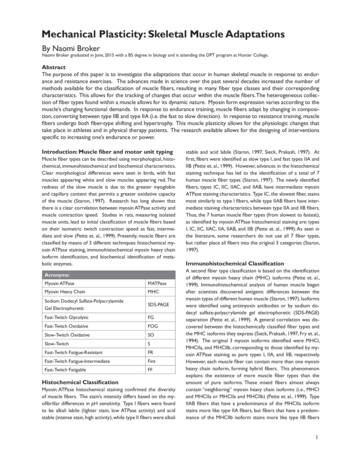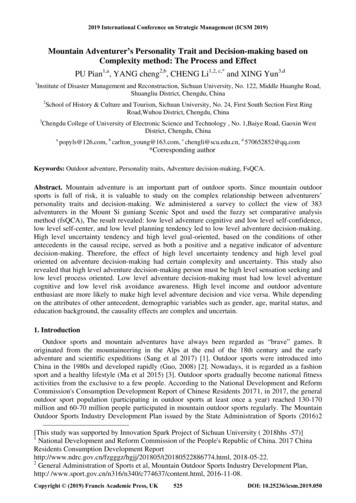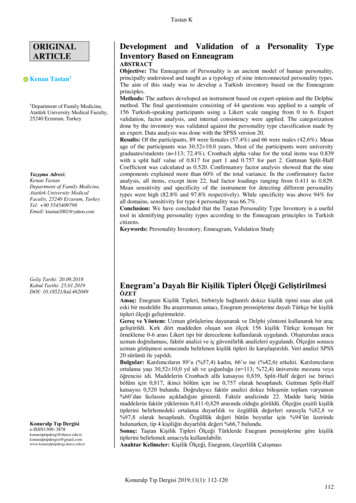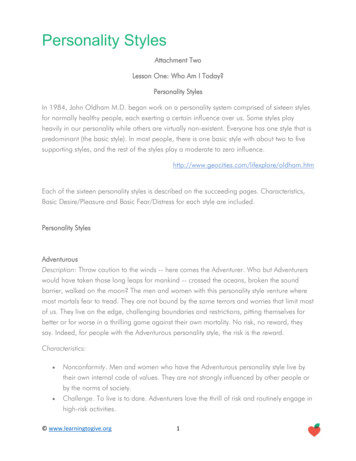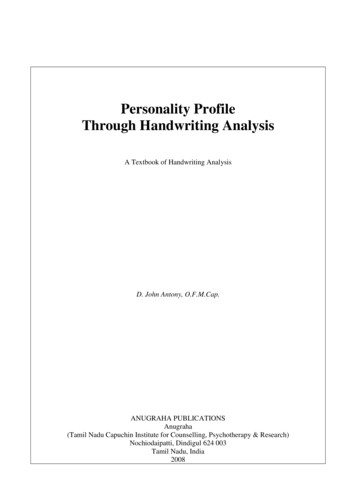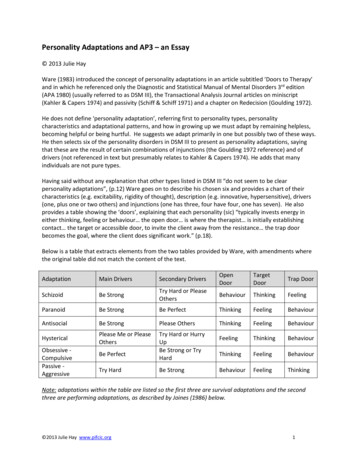
Transcription
Personality Adaptations and AP3 – an Essay 2013 Julie HayWare (1983) introduced the concept of personality adaptations in an article subtitled ‘Doors to Therapy’and in which he referenced only the Diagnostic and Statistical Manual of Mental Disorders 3rd edition(APA 1980) (usually referred to as DSM III), the Transactional Analysis Journal articles on miniscript(Kahler & Capers 1974) and passivity (Schiff & Schiff 1971) and a chapter on Redecision (Goulding 1972).He does not define ‘personality adaptation’, referring first to personality types, personalitycharacteristics and adaptational patterns, and how in growing up we must adapt by remaining helpless,becoming helpful or being hurtful. He suggests we adapt primarily in one but possibly two of these ways.He then selects six of the personality disorders in DSM III to present as personality adaptations, sayingthat these are the result of certain combinations of injunctions (the Goulding 1972 reference) and ofdrivers (not referenced in text but presumably relates to Kahler & Capers 1974). He adds that manyindividuals are not pure types.Having said without any explanation that other types listed in DSM III “do not seem to be clearpersonality adaptations”, (p.12) Ware goes on to describe his chosen six and provides a chart of theircharacteristics (e.g. excitability, rigidity of thought), description (e.g. innovative, hypersensitive), drivers(one, plus one or two others) and injunctions (one has three, four have four, one has seven). He alsoprovides a table showing the ‘doors’, explaining that each personality (sic) “typically invests energy ineither thinking, feeling or behaviour the open door is where the therapist is initially establishingcontact the target or accessible door, to invite the client away from the resistance the trap doorbecomes the goal, where the client does significant work.” (p.18).Below is a table that extracts elements from the two tables provided by Ware, with amendments wherethe original table did not match the content of the text.AdaptationMain DriversSecondary DriversOpenDoorTargetDoorTrap DoorSchizoidBe StrongTry Hard or PleaseOthersBehaviourThinkingFeelingParanoidBe StrongBe PerfectThinkingFeelingBehaviourAntisocialBe StrongPlease OthersThinkingFeelingBehaviourHystericalPlease Me or PleaseOthersTry Hard or HurryUpBe Strong or viourBehaviourFeelingThinkingObsessive CompulsivePassive AggressiveBe PerfectTry HardBe StrongNote: adaptations within the table are listed so the first three are survival adaptations and the secondthree are performing adaptations, as described by Joines (1986) below. 2013 Julie Hay www.pifcic.org1
Joines (1986) wrote of how failures with the redecision therapy model could be avoided if therapistsused personality adaptations (Ware 1983) and particularly the guide on contact and target areas. Healso gave new names to the adaptations and separated them into three primary or survival adaptationsthat develop in the first three years of life, and three secondary adaptations that develop in the secondthree years of life.The primary are Schizoid – Creative Daydreamer, Paranoid – Brilliant Sceptic, Antisocial – CharmingManipulator: the secondary are Passive-Aggressive – Playful Critic, Obsessive-Compulsive – ResponsibleWorkaholic, Hysterical – Enthusiastic Overreactor. He also wrote that many combinations are possible,from only one survival adaptation to more that one of both, wit most people having one of each. Hence,the therapist needs to shift contact, or door, as the client moves between adaptations. Joines givesdetails of how to work with each adaptation and for typical combinations (for up-to-date details thereader is referred to Joines & Stewart 2002).In a later article, Joines (1988) produced a variation adapted from Kaplan et al (1984), of the “OK Corral”(Ernst 1971) in which the axes were You’re OK/Not OK Attached (Near to Others) (vertical) and I’mOK/Not OK Individualised (Near to Self) (horizontal). He used dashed, dotted and solid lines respectivelyto indicate sense-of-self boundaries as circles within square interpersonal boundaries. He then addedinto appropriate quadrants diagrams of ego state contamination, exclusion or impasse along with eachadaptation.This diagram is reproduced, with minor changes, in Joines & Stewart (2002). It is interesting to note thattwo surviving adaptations (paranoid and antisocial) are shown in the I’m OK, You’re Not OK quadrant,two performing (hysterical, now called histrionic, and obsessive-compulsive) in the I’m not OK, You’reOK sector, and one of each (schizoid and passive-aggressive) in the I’m not OK, You’re not OK quadrant.Harman (1991) referenced Ware (1983) and Joines (1986) when she related personality adaptations tothe treatment of adults from alcoholic homes. She pointed out that Joines had changed the names toless pejorative terms to emphasise that adaptations range from healthy to pathological. Sheconcentrated on the obsessive-compulsive adaptation as being commonly found in adult children ofalcoholics, and based on Ware’s (1983) description of them, wrote that they are “super conformists whoare overly conscientious and extremely critical of themselves [with] Be Perfect and Be Strong Don’tBe a Child, Don’t Feel and Don’t Be Close contact door is through thinking, their target door is feeling,and the trap door is behaviour.” (p.32). Harman gives several case studies but concludes thatcategorising clients using only one model would unnecessarily limit the range of possible interventions.When the Joines & Stewart (2002) book entitled Personality Adaptations was published, they wrote that“we show you how to diagnose personality adaptations rapidly and accurately – after only a fewminutes interaction, and without the need for “history-taking” – by observing certain distinctivebehavioural clues known as driver behaviours” (italics in original) (p.ix). They say that this will allow youto gain quick and reliable insight into: typical modes of social relating, approach to problem-solving,communication style, initial and ongoing contact areas, life patterns, principle issues during personalchange, and how to work with them. This of course is similar to, although not as powerful as, Kahler’s(1975) statement that “the stopping of the driver behaviour also prevents the concurrent scriptsentence (thought) patterns.” (p.280) and “If a person changes driver formed sentences, he (sic) maychange his whole life (process) script pattern.” (p.283). 2013 Julie Hay www.pifcic.org2
Joines and Stewart acknowledge Kahler and Ware for permission to use copyright material, and includea statement from Kahler Communications Inc to the effect that process communications model materials may only be taught by duly licensed or accredited therapists or counsellors and may not betaught at all in non-clinical settings without Kahler Communications Inc certification.There is too much content in the Joines & Stewart book to produce a meaningful summary here: thosewishing to work with their process are recommended to read the book – and train with the authors.However, for those seeking self awareness, Joines & Stewart present information on parenting styles asfollows:Schizoid – underdone, tentative – so child withdraws or cares for parentsAntisocial – overdone, anticipating but then missing – so child attention-seeks or manipulatesParanoid – inconsistent, unpredictable – so child becomes hypervigilant and controlledPassive-Aggressive – over-controlling – so child attempts tenacity and then stubbornessObsessive-Compulsive – achievement focused – so child over achievesHistrionic – emphasise keep people happy – so child is emotionally reactive and centre of attentionThree years after the book appeared, White (2005) produced a critique of the theory of personalityadaptations, and particularly of Ware’s (1983) article. White points out that Ware had no TAqualification, does not explain how he decided on the six adaptations, nor why he excluded others in theDSM III. He notes that Joines & Stewart address the last point by saying that the other DSM IIIclassifications are combinations of the six: White says this is a circular argument. He also challenges theirview that narcissist and borderline lack healthy versions, which White disputes, and that they cannot bemapped on the Assessing Quadrant, which White says is a problem with the Quadrant. White also notesthe omission of dependent personality, before going on to present his own material including ego statepatterns against the three groups of personality traits and disorders within DSM IV (APA 1994).White’s critique appears to have been published only on the internet, whereas three years later Tudor &Widdowson (2008) provided a similar “critique of the Process Model and Personality Adaptations.” (partof article title, p.218). In addition to the omissions of DSM IV classifications, they also identify thefollowing problems: the myth of universal explanation – it is not possible to explain so much with onetheory; the seduction of being too simplistic – is reductionist; the confusion of being too complicated –especially as individuals have a mix of adaptations; the underdevelopment of development – themodels are not supported by research in child development; the danger of diagnosis – quoting Steiner(1971) that diagnosis is a form of alienation unless based on organic factors plus, for good measure herethey mention inconsistency, limitation, discounting, partiality and inaccuracy; and the individualisationof the person – because it locates pathology within the intrapsychic process and ignores the social,cultural and interactional context.During the same year, Kahler’s (2008) book on the Process Therapy Model appeared. This contains astatement that “Teaching or training of the material in this book requires certification by Taibi KahlerAssociates Inc or one of its authorised affiliate organisations.” (before title page). Hence, again you willneed to get the book if you wish to know more. However, Kahler does describe the considerableamount of research conducted that supports the current version of the model, and how research atNASA (interviewing for astronauts) during 1979-1982 helped him re-analyse the 1972 research data witha new hypothesis that gave significance at the .01 level. 2013 Julie Hay www.pifcic.org3
Three years later, Joines (2011) responded to the critique by Tudor & Widdowson. He referred to his 30years of clinical work with clients and the questionnaire he uses (Joines 2002). He challenged what heregarded as misunderstandings, pointed out that he does not use Kahler’s process model; this had beenadded to the book by Stewart and subsequently criticised by Kahler (Note: Kahler 2008 included in thatbook the apology he had received from Joines & Stewart). Joines went on to address the specificcriticism of simplicity, defined a personality adaptation as “a combination of innate characteristics plusthe way an individual adjusts his or her behaviour in order to survive physically and/or psychologicallyand to get along well in his or her family of origin.” (p.93-94), explained that personality disorders aremainly the negative sides of adaptations and that some disorders are combinations; and pointed outthat narcissistic is due to be omitted as a type in DSM V (APA 2013) and become a trait forantisocial/psychopathic type.Personality StylesBased on personal notes taken at a conference workshop led by Kahler during the mid 1970s, andsupplemented by booklets by Kahler (1979a, 1979b), Hay (1995, 2001, 2009) developed an alternative,simplified view of styles within a framework she called AP3 because the three axes were each labelledwith A and P.Hay (2009) begins her description of the model with the following caveats: “This is a simplification of material that has been developed in great depth by therapists. See mynotes about Taibi Kahler at the end of this chapter. We can’t really fit people into boxes. We do it so we can have a framework to guide us in choosingour own behaviours so we will maximise our chances of getting on with people. People are immensely interesting and varied individuals so use the framework tentatively – don’tallocate someone to a box and then get annoyed when they don’t do everything in the waypredicted by that box.” ( p. 184)The following is an extract, with permission, from pages 184-194 of the 2009 book.Imagine a cube, as shown in Figure 1, for which there is height, width and depth. Imagine that thesethree dimensions are, respectively:active – passive – do we initiate contact and move towards people and goals – or do we respond tocontacts and goals initiated by others?alone – people – do we prefer to be, or work, alone – or would we rather be functioning within a groupof people, perhaps as the central figure?acceleration – patience – do we prefer to do things quickly, perhaps even with ever-increasing speed –or do we like to take our time, doing things slowly and carefully? 2013 Julie Hay www.pifcic.org4
Note that the acceleration – patience dimension runs from the top right-hand corner at the back to thebottom left-hand corner at the front rather than simply from back to front. I will come back to this later.Identifying the StylesWe will concentrate first on the four AP³ styles that fit within the height and width dimensions of thecube. We can show these as if they are 4 boxes created by the axes, as in Figure 2.The following are some ideas on how you might recognise the different types (and, of course, positionyourself!). As you read the descriptions, imagine that the individual (or you) has arrived at a conference.They are expecting this to be mainly work-based but with a significant element of socialising. Theyarrive before the first formal session is due to start – and come into a large room where people arehaving coffees or cocktails, chatting with each other, meeting
Personality Adaptations and AP3 . This of course is similar to, although not as powerful as, Kahlers (1975) statement that the stopping of the driver behaviour also prevents the concurrent script sentence (thought) patterns. (p.280) and If a person changes driver formed sentences, he (sic) may change his whole life (process) script pattern. _ (p.283). 2013 Julie Hay www.pifcic.org 3 .
